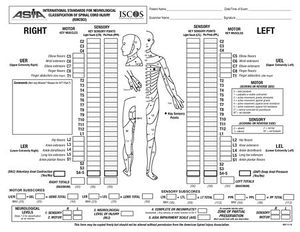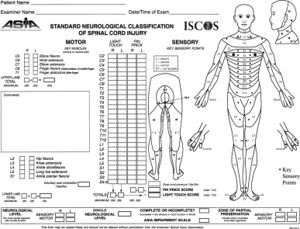Gait Post Spinal Cord Injury: Difference between revisions
No edit summary |
No edit summary |
||
| Line 28: | Line 28: | ||
The '''American Spinal Injury Association (ASIA)''' created the ''International Standards for Neurological'' ''Classification of Spinal cord injury'' (ISNCSCI) which provides a standardized examination method to determine the extent of motor and sensory function loss after a spinal cord injury (SCI) for establishing prognosis and is an important tool for clinical research trials.<ref name=":0" /> | The '''American Spinal Injury Association (ASIA)''' created the ''International Standards for Neurological'' ''Classification of Spinal cord injury'' (ISNCSCI) which provides a standardized examination method to determine the extent of motor and sensory function loss after a spinal cord injury (SCI) for establishing prognosis and is an important tool for clinical research trials.<ref name=":0" /> | ||
The neurological level is defined as the most caudal level of the spinal cord with normal motor and sensory function on both the left and right sides of the body. Motor level is referred to as the most caudal segment of the spinal cord with normal motor function bilaterally. Sensory level is defined in the same way except in terms of sensory function. Sensory level is determined by testing the patient’s sensitivity to light touch and pinprick on the left and right side of the body at key dermatomes. Scoring of sensation is based on a 3-point ordinal scale where 0 = absent, 1 = impaired, and 2 = normal. Motor level is determined by testing the strength of a key muscle on the right and left side of the body at myotomes adjacent to the suspected level of impairment. Key muscle strength is scored using the 6-point ordinal scale commonly used for manual muscle testing. <ref>O'sullivan, S.B, Schmitz , T.J, Fulk, G.D. Physical Rehabilitation. (6th ed.). Philadelphia: FA Davis Company; c2014.</ref> | The neurological level is defined as the most caudal level of the spinal cord with normal motor and sensory function on both the left and right sides of the body. Motor level is referred to as the most caudal segment of the spinal cord with normal motor function bilaterally. Sensory level is defined in the same way except in terms of sensory function. Sensory level is determined by testing the patient’s sensitivity to light touch and pinprick on the left and right side of the body at key dermatomes. Scoring of sensation is based on a 3-point ordinal scale where 0 = absent, 1 = impaired, and 2 = normal. Motor level is determined by testing the strength of a key muscle on the right and left side of the body at myotomes adjacent to the suspected level of impairment. Key muscle strength is scored using the 6-point ordinal scale commonly used for manual muscle testing. <ref>O'sullivan, S.B, Schmitz , T.J, Fulk, G.D. Physical Rehabilitation. (6th ed.). Philadelphia: FA Davis Company; c2014.</ref> | ||
[[File:Asia scale.jpg|thumb| | [[File:Asia scale.jpg|thumb|left]][[File:Scm-34-535-i1.jpg|thumb|center]] | ||
{| class="wikitable" | |||
= | !Grades | ||
! | |||
! | |||
!Degree Of Impairment | |||
|- | |||
|'''A''' | |||
|= | |||
|'''Complete''' | |||
|No sensory or motor function is preserved in the sacral segments S4-S5. | |||
|- | |||
|'''B''' | |||
|= | |||
|'''Sensory Incomplete''' | |||
|Sensory but not motor function is preserved below the neurological level and includes the sacral segments S4-S5, AND no motor function is preserved more than three levels below the motor level on either side of the body. | |||
|- | |||
|'''C''' | |||
|= | |||
|'''Motor Incomplete''' | |||
|Motor function is preserved below the neurological level**, and more than half of key muscle functions below the single neurological level of injury have a muscle grade less than 3 (Grades 0–2). | |||
|- | |||
|'''D''' | |||
|= | |||
|'''Motor Incomplete''' | |||
|Motor function is preserved below the neurological level**, and at least half (half or more) of key muscle functions below the NLI have a muscle grade >3. | |||
|- | |||
|'''E''' | |||
|= | |||
|'''Normal''' | |||
|If sensation and motor function as tested with the ISNCSCI are graded as normal in all segments, and the patient had prior deficits, then the AIS grade is E. Someone without a SCI does not receive an AIS grade. | |||
|} | |||
<nowiki>**</nowiki>For an individual to receive a grade of C or D, i.e. motor incomplete status, they must have either voluntary anal sphincter contraction or sacral sensory sparing (at S4/5 or Deep Anal Pressure (DAP)) with sparing of motor function more than three levels below the motor level for that side of the body. The Standards at this time allows even non-key muscle function more than 3 levels below the motor level to be used in determining motor incomplete status (AIS B versus C). <ref name=":0" /> | |||
== References == | == References == | ||
Revision as of 15:33, 11 September 2020
Original Editor - Prit Shah
Top Contributors - Prit Shah, Naomi O'Reilly, Kim Jackson and Nikhil Benhur Abburi
Introduction[edit | edit source]
The recovery or improvement of ambulation after a Spinal cord injury (SCI) is such an important goal because people who can walk independently are more likely to be able to participate in expected social roles and desired recreational activities, have a higher quality of life, and have improved health status.
The ability to walk after a Spinal cord injury (SCI) depends on many factors including your:
- Level of injury.
- Severity of injury.
- Time since injury.
- Age.
- Level of fitness.
- Level of sensation
- Other related problems such as spasticity and joint problems (contractures).
- Level of pain. [1]
Therefore, it is difficult to predict if a patient will ever regain his walking ability and especially at what point of time in his rehabilitation. Some patients take a few months up to a year and some take many years.
Identifying The Level Of Lesion[edit | edit source]
The designation of level of lesion in the spinal cord and the extent of motor and sensory function after injury has a large impact on the medical and rehabilitation needs of the individual.
Complete And Incomplete Injuries and Zones of Preservation[edit | edit source]
The International Standards for Neurological Classification of Spinal cord injury (ISNCSCI) defines a complete injury as having no sensory or motor function in the lowest sacral segments (S4 and S5). Sensory and motor function at S4 and S5 are determined by anal sensation and voluntary external anal sphincter contraction. An incomplete injury is classified as having motor and/or sensory function below the neurological level including sensory and/or motor function at S4 and S5. If an individual has motor and/or sensory function below the neurological level but does not have function at S4 and S5, then the areas of intact motor and/or sensory function below the neurological level are termed zones of partial preservation. [2]
ASIA Impairment Scale[edit | edit source]
The American Spinal Injury Association (ASIA) created the International Standards for Neurological Classification of Spinal cord injury (ISNCSCI) which provides a standardized examination method to determine the extent of motor and sensory function loss after a spinal cord injury (SCI) for establishing prognosis and is an important tool for clinical research trials.[2]
The neurological level is defined as the most caudal level of the spinal cord with normal motor and sensory function on both the left and right sides of the body. Motor level is referred to as the most caudal segment of the spinal cord with normal motor function bilaterally. Sensory level is defined in the same way except in terms of sensory function. Sensory level is determined by testing the patient’s sensitivity to light touch and pinprick on the left and right side of the body at key dermatomes. Scoring of sensation is based on a 3-point ordinal scale where 0 = absent, 1 = impaired, and 2 = normal. Motor level is determined by testing the strength of a key muscle on the right and left side of the body at myotomes adjacent to the suspected level of impairment. Key muscle strength is scored using the 6-point ordinal scale commonly used for manual muscle testing. [3]
| Grades | Degree Of Impairment | ||
|---|---|---|---|
| A | = | Complete | No sensory or motor function is preserved in the sacral segments S4-S5. |
| B | = | Sensory Incomplete | Sensory but not motor function is preserved below the neurological level and includes the sacral segments S4-S5, AND no motor function is preserved more than three levels below the motor level on either side of the body. |
| C | = | Motor Incomplete | Motor function is preserved below the neurological level**, and more than half of key muscle functions below the single neurological level of injury have a muscle grade less than 3 (Grades 0–2). |
| D | = | Motor Incomplete | Motor function is preserved below the neurological level**, and at least half (half or more) of key muscle functions below the NLI have a muscle grade >3. |
| E | = | Normal | If sensation and motor function as tested with the ISNCSCI are graded as normal in all segments, and the patient had prior deficits, then the AIS grade is E. Someone without a SCI does not receive an AIS grade. |
**For an individual to receive a grade of C or D, i.e. motor incomplete status, they must have either voluntary anal sphincter contraction or sacral sensory sparing (at S4/5 or Deep Anal Pressure (DAP)) with sparing of motor function more than three levels below the motor level for that side of the body. The Standards at this time allows even non-key muscle function more than 3 levels below the motor level to be used in determining motor incomplete status (AIS B versus C). [2]
References[edit | edit source]
- ↑ Spinal Cord Injury and Gait Training. Available at - https://msktc.org/sci/factsheets/Gait-Training-and-SCI
- ↑ 2.0 2.1 2.2 Kirshblum SC, Biering-Sorensen F, Betz R, Burns S, Donovan W, Graves DE, Johansen M, Jones L, Mulcahey MJ, Rodriguez GM, Schmidt-Read M. International standards for neurological classification of spinal cord injury: cases with classification challenges. The journal of spinal cord medicine. 2014 Mar 1;37(2):120-7
- ↑ O'sullivan, S.B, Schmitz , T.J, Fulk, G.D. Physical Rehabilitation. (6th ed.). Philadelphia: FA Davis Company; c2014.








